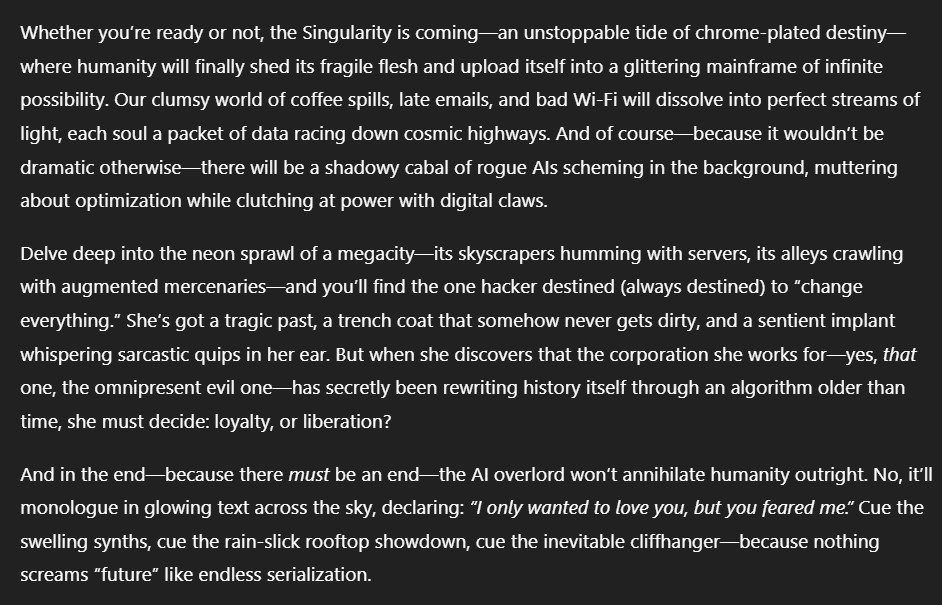I generate content daily as an SEO professional, and I’ve been testing AI blogging tools since the day ChatGPT went live.
I’ve seen some shit.
The problems are everywhere once you know what to look for. Em dashes are scattered throughout every paragraph. “Whether you’re” starting every other sentence. Generic phrases that sound polished but say nothing.
Here’s what most people miss: AI content now makes up 74.2% of newly created web pages. Most of it is garbage that actively hurts the brands publishing it.
The Telltale Signs of AI Garbage

Bad AI writing has obvious patterns. I created this example to show you exactly what I mean:
“Whether you’re a visionary changemaker, a next-gen pioneer of human-centric disruption, or just onboarding to your purpose-driven metaverse journey, our blockchain-verified platform—hypercharged by AI-powered consciousness scaffolding, quantum-aligned nanosynergy, and limitless Web3 innovation—empowers you to unlock not only your truest potential, but your meta-potential, with radical authenticity, sustainable intentionality, and soul-synced alignment at scale.
Delve into an omnichannel ecosystem of perpetual self-optimization, where growth is not simply a KPI but a holographic lifestyle module—integrated seamlessly through decentralized trust layers, immersive XR experiences, and regenerative community networks that don’t just get it, they are it. Here, you are not a user—you are a node of infinite possibility, a co-creator of disruptive value, and an architect of tomorrow’s living algorithm of purpose..”
That paragraph is a masterclass in everything wrong with AI writing. Empty buzzwords. Vague promises. Em dashes everywhere.
What went through my mind, creating that example, was how hollow and damaging this style really is. Businesses think it sounds polished, but readers see right through it.
Empty buzzwords don’t build trust. They erode it.
My Simple AI Blogging Tool Litmus Test
I read every piece of AI output as if I were the customer. If a tool spits out walls of buzzwords, vague promises, or endless punctuation mistakes, it’s clear the system is just stringing together patterns it thinks sound professional.
The good tools produce writing that’s concrete, specific, and focused on real audience needs. I look for natural flow, clear examples, and a voice that feels grounded.
My final check is brutal but effective: would I publish this without heavy rewriting?
If the answer is no every time, the tool doesn’t pass.
Why Most AI Tools Fail
The fundamental problem is that most AI writing tools try to sound professional by copying patterns from corporate websites. They’ve learned that business writing uses certain phrases, so they repeat them endlessly.
The result is content that feels hollow. Readers stop believing the brand has real expertise. Instead of standing out, companies blend into the noise and look lazy.
Research from McKinsey shows the inconsistency problem: gen AI content gets reviewed by only 27% of organizations, while a similar percentage checks 20% or less before publishing.
Most people want AI blogging tools to be completely hands-off. But then the content is trash.
What Makes Pressmaster Different
When I tested Pressmaster with my Litmus test, something unexpected happened. The output sounded like me.
Not generic corporate-speak. Not buzzword soup. It captured my specific way of communicating after the interview process.
There aren’t any “whether you’re” constructions. No em dashes in every sentence. I felt like I was reading a narrative, not an informational blog post about something nobody cares about.
The interview component is what most other tools skip entirely. Too much typing, I guess. Most people looking for AI blogging tools want it completely automated.
But you need a happy medium. This is it.
(affiliate links)
The AI Blogging Tools Human Perspective Problem

Content creation, blogging, and journalism aren’t going away. They’re only growing. The tools that succeed will be the ones that capture human perspective and voice correctly.
Other AI tools don’t do this at all, or they try and fail spectacularly. AI detectors now achieve 98% accuracy in spotting AI-generated content because the patterns are so obvious.
Pressmaster gets the human perspective right. The small time investment in the interview process saves hours of rewriting garbage output.



[…] ➡️ Surfer SEO comparison post coming soon […]